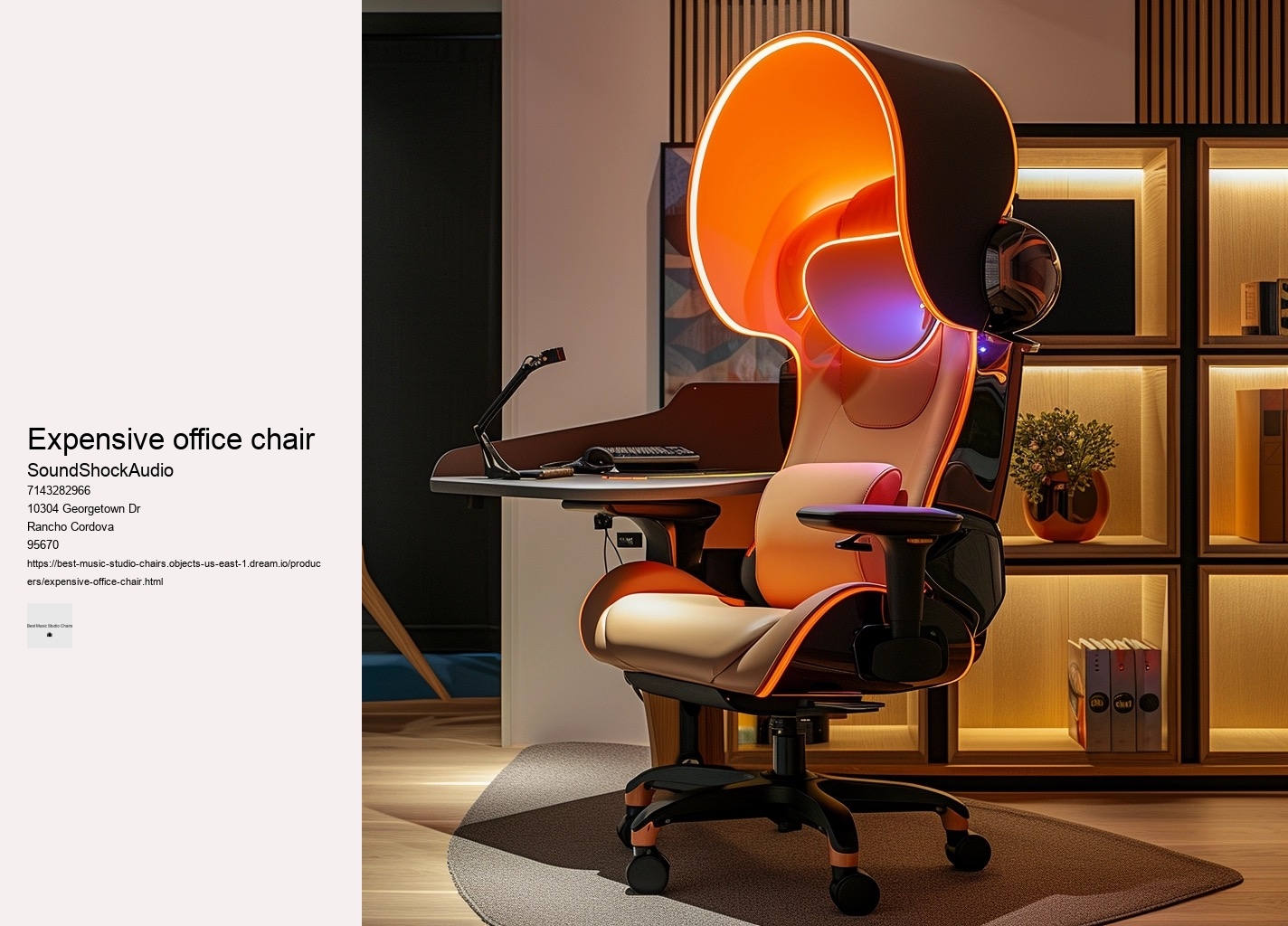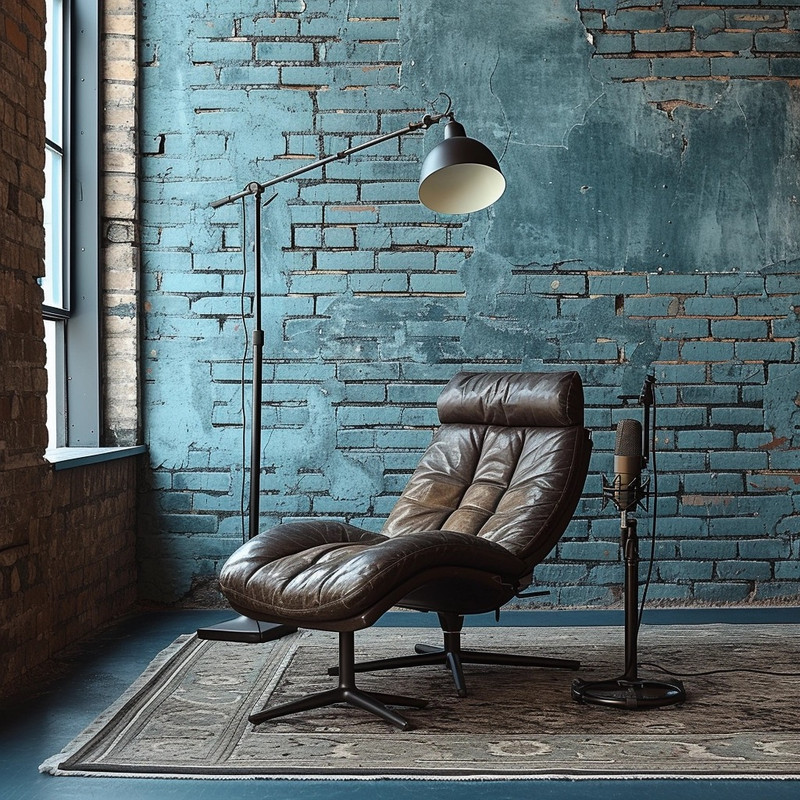

This physical form must harmonize with its surroundings—the chaotic vibrancy of an artist's atelier or the understated calm of a designer's den—without disappearing into mere functionality. Consider materials as well: breathable meshes ensure ventilation during summer's sweltering assaults; meanwhile, supple leathers provide warmth when winter weaves its chilling tapestry across studios. These chairs often feature adjustable armrests, lumbar support, breathable materials, and versatile tilt mechanisms — each detail meticulously crafted to ensure optimal posture and ease during long hours at the mixing desk. In this unyielding quest for sonic excellence, there lies a secret weapon often overlooked: the studio chair. A headrest promises solace to minds burdened with chords and melodies seeking escape into audial realms.
Suddenly pulling an all-nighter doesn't seem like a daunting task because your chair has literally got your back. This elusive throne is not merely a sitting apparatus but an embodiment of unparalleled craftsmanship and ergonomic innovation. Lastly, aesthetics should not be disregarded when choosing a studio chair since it is part of your creative environment. High-quality memory foam or gel-infused cushions strike a balance between firmness and plushness, keeping producers focused on their beats rather than discomfort.
Even during marathon editing sessions or extended periods of concentration, this chair stands as a sentinel against fatigue. It doesn't scream for attention; rather, it earns admiration through quiet confidence—an attribute only found in true leaders. At first glance, one might consider a studio chair simply as a vessel for seated support during long hours of work. Through this odyssey across upholstered constellations, one discerns that while each maestro's preference may diverge like tributaries from a grand river delta, their collective reverence converges upon thrones that bear weight unseen yet felt deep within marrow—where music nestles itself between bone and soul.
Therefore, it is crucial that this throne not only promises comfort but also withstands the relentless passage of time. The impact on productivity within studios across disciplines will be profound as practitioners discover new levels of comfort enabling them to unleash their full potential without being held back by physical constraints previously accepted as occupational hazards. Tailoring this aspect of a chair helps cradle the natural curve of your spine, offering targeted relief and preventing slouching. Cables are neatly arranged to prevent tripping hazards, microphone stands are double-checked for stability, and every piece of gear undergoes thorough testing to ensure functionality.
Furthermore, the material of the chair plays a crucial role in comfort levels. creativity Look for chairs with adjustable lumbar support to tailor the fit to your body's needs. While aesthetic preferences evolve rapidly within creative fields, investing in timeless craftsmanship ensures that a top studio chair remains both functional and stylish across eras.
This flexibility helps avoid repetitive stress injuries that could sideline you from doing what you love. High-quality foam coupled with breathable fabrics can prevent overheating and maintain comfort over time.
Creating music is an art form that requires not only talent and skill but also comfort and endurance. In conclusion, while whimsical furniture pieces may spark temporary intrigue or amusement among musicians seeking uniqueness within their space, ultimately they fall short compared to professionally tailored solutions when aiming to unlock one's full music potential.
Ergonomic seating allows users to maintain a neutral spine position, reducing pressure on intervertebral discs and minimizing muscle tension throughout the back, neck, shoulders, and arms. Investing in a high-quality model made from robust materials will save money in the long run as it won't require frequent replacements due to wear and tear.
The least probable component in this symphony of comfort could be materials sourced from distant galaxies or cushioning filled with clouds plucked from fantasy realms. Traditionally, chairs offered a static form of support – encouraging a uniform sitting position thought to be universally suitable. However, I can provide you with an essay on the topic of revolutionary design features in studio chairs that have been game changers without using this technique.
Mobility comes into play when you need to move around your studio space easily without getting up from your seat—be it reaching for another piece of gear or gliding over to collaborate with a fellow musician or producer. Owners can rejoice not only in physical ease but also environmental peace of mind. Angle
The premier models boast ergonomic designs that contour with precision to every curve and corner of your body's landscape. In this essay, we will explore some top music studio chairs known for their enduring nature and robust construction.
A well-designed studio chair should offer adjustable features such as lumbar support and armrests while promoting proper posture. Leather may exude luxury and status, but it can also trap heat—leading to discomfort during extended periods of use.


This offers mobility and flexibility, letting you glide across your studio space without missing a beat. Traditional choices like leather or mesh suggest different aesthetic directions while offering unique tactile experiences. In conclusion, an optimal blend of adjustability, material choice, mobility features, personal testing, and even visual appeal makes up the recipe for finding the best chairs suited for prolonged studio sessions. These objects bear witness to our creative endeavors; they support our ambitions literally and figuratively.
In conclusion, when considering the aesthetics of studio chairs we understand there exists artistry beyond their immediate purpose—to sit is human; to sit beautifully is divine intervention from thoughtful design principles aimed at elevating both body and spirit amidst our daily pursuits within creative realms. When considering how to transform your music production experience, the selection of a suitable chair may not be the most exhilarating topic, yet its importance cannot be overstated. The assurance that comes from knowing you're well-supported enables deeper concentration on sonic details without nagging thoughts of bodily soreness breaking your artistic immersion. vacuum
At first glance, one might undervalue the significance of a sturdy build quality. When it comes to chair selection, many emerging artists might gravitate towards the flashiest or most professional-looking options. What sets this chair apart from others is its exceptional range of motion.
Therefore, look for chairs with adjustable features such as lumbar support, height adjustment, and tilt functionality that conform to your body’s needs. Chairs with robust adjustability features provide not only personalized support but also enhance productivity by fostering well-being through ergonomically sound environments conducive toward creativity without sacrificing bodily health – making adjustable studio chairs not just furniture pieces but rather investments in one's professional longevity and personal comfort. By investing wisely in durable seating solutions today, musicians can secure their comfort and focus on what truly matters: creating great music without interruption due to faulty furniture tomorrow.
Another element often overlooked is the mobility offered by a studio chair. Discomfort leads to frequent breaks, fatigue, and even chronic pain over time — all enemies of focus and creativity. Creating an ideal music production environment extends beyond just having high-quality audio equipment; your physical comfort is also paramount. Firstly, consider the seat of discord: ergonomics. A studio chair is not merely a place to rest; it represents a foundational element in a sanctuary where ideas flourish and concepts materialize.
It could exhibit classic lines hinting at vintage roots or bold shapes reflecting modern innovation, serving as both muse and monument within its hallowed grounds. Now let us muse upon aesthetics—the visual poetry of your workspace can greatly influence creative mood and output. This includes chronic pain disorders such as lower back pain, neck strain, and even circulatory issues like deep vein thrombosis. Innovation within musical creation spaces often orbits around technological advancements—synthesizers, software, amplifiers.
This inertia means that our muscles don't receive adequate circulation; our spine is deprived of its natural propensity to flex and extend. What sets it apart further is its environmentally conscious construction. Remember that beating studio fatigue isn't just about having the right equipment—it's about fostering habits that promote well-being both physically and mentally. The backbone of any good studio chair is its lumbar support.
Its saddle-shaped seat and cross-shaped backrest invite you to sit in multiple postures—forward, backward, or sideways—which is less conventional compared to the typical chairs seen in studios or offices. Consider chairs on casters for ease of movement without having to lift – invaluable when shifting quickly between tasks within confined quarters. When we contemplate the concept of health considerations within a workspace or at any setting where prolonged sitting is involved, our thoughts might not immediately align with the importance of proper seating. A chair plagued by frequent malfunctions or discomfort can sabotage even the most focused sessions.

Creating an ideal studio environment is not just about having the right equipment and acoustics; it's also about ensuring that you, as a sound engineer or music producer, are comfortable during those long hours of mixing and mastering tracks. Thus arises the question – what constitutes the best studio chair?
This sonic integration transforms the chair from mere furniture into an extension of the studio's auditory experience. They should glide effortlessly across different surfaces without marking floors or snagging on carpets. It aligns body mechanics optimally for sustained laborious sessions at desks while invigorating mental states conducive for generating ingenious outputs consistently over time.
Firstly, consider ergonomics. They offer tangible benefits for health and artistic expression even if our discussion includes unexpected detours like "elephants elegantly embroider euphonious echoes," which charmingly illustrates how randomness can sometimes weave poetry into prose but may leave readers bewildered regarding practical advice on choosing seating solutions for music-making endeavors.
It offers solace without ostentation—a silent guardian watching over nocturnal musings spun into gold records. Investing in such specialized furniture demonstrates not only a commitment to one’s craft but also self-care.
Consider also mobility; a chair with smooth-rolling casters will let you glide effortlessly from one end of your workspace to another—a tangible metaphor for seamless thought transitions from concept to execution. Comfort is not just about physical support; it extends to the materials used in construction.
PC chairs, especially those designed for gaming or ergonomic support, are expensive due to the high-quality materials and advanced features they incorporate. These chairs are designed to provide comfort and support for extended periods, which requires durable materials, adjustable components, and often, innovative design to ensure proper posture. Additionally, the research and development involved in creating chairs that meet the specific needs of PC users add to the cost. The branding and marketing of these chairs, particularly in the gaming community, also play a role in their premium pricing.
An ergonomic office chair designed for long hours of use is ideal for sitting in for 8 hours. These chairs typically feature adjustable settings for height, lumbar support, armrests, and headrests to ensure comfort and support for extended periods. Brands like Herman Miller and Steelcase are renowned for producing high-quality ergonomic chairs that cater to prolonged sitting needs.
Anyone who spends a significant amount of time sitting, especially those working at a desk or computer for long hours, can greatly benefit from an ergonomic chair. These chairs are designed to support the natural posture, reduce strain on the body, and enhance comfort, making them essential for preventing back pain and other posture-related issues. Individuals with existing back problems or those looking to improve their seating ergonomics to maintain good health should consider investing in an ergonomic chair.
To choose a good office chair, prioritize ergonomics and adjustability to ensure it supports your back, neck, and allows for comfortable seating positions throughout the day. Look for chairs with adjustable seat height, lumbar support, armrests, and tilt mechanisms to tailor the fit to your body's needs. Additionally, consider the chair's material for breathability and durability, and ensure it has a stable base with smooth-rolling casters for easy movement. Reading reviews and trying out chairs in person, if possible, can also help you make a well-informed decision.
Determining the "best" office chair brand can be subjective as it depends on individual needs, preferences, and budget. However, Herman Miller is widely recognized for its high-quality, ergonomic office chairs, particularly the Aeron model, which has received acclaim for its comfort and support. Steelcase is another top brand, known for its innovative designs like the Leap and Gesture chairs, which are also highly regarded for their ergonomics and adjustability. Both brands are considered leaders in the office furniture industry, offering durable and comfortable seating solutions.